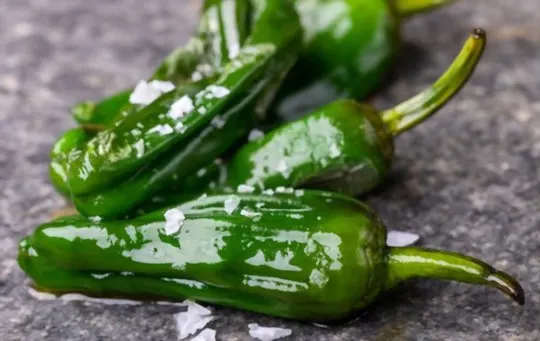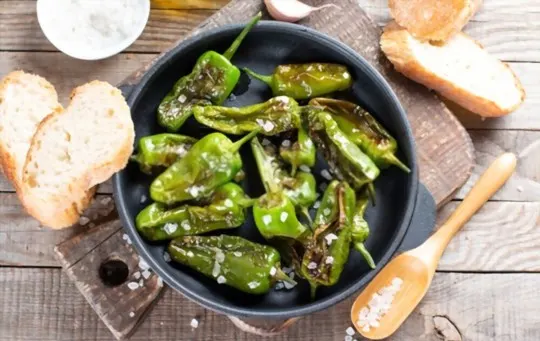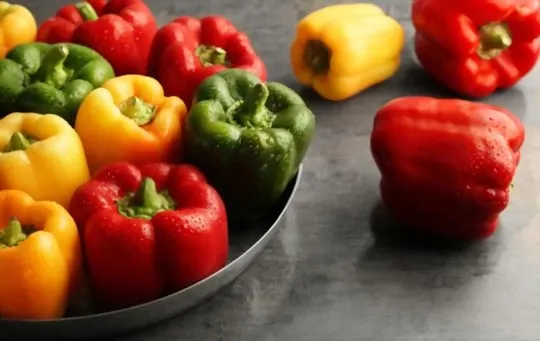In the grand kitchen scheme, pimientos and bell peppers sure stir up a debate.
Both are staples in dishes worldwide, yet they couldn’t be more different.
We’ve all been there, scratching our heads at the grocery store.
Is one sweeter? Spicier? What makes them tick?
Here’s the lowdown. Pimientos pack a sweet punch; think of them as the milder cousin.
Bell peppers? They’re the versatile MVP of the veggie drawer.
Ever tossed a bell pepper into a stir-fry and thought, “Wow, this adds the perfect crunch”?
Or bitten into a pimiento cheese spread and felt your taste buds do a happy dance? That’s what we’re talking about.
This isn’t just food talk; it’s a peek into two veggie titans’ lives.
Grab your apron, and let’s get chopping.
What is a Pimiento?

Pimientos, a type of pepper originating from Spain, are often confused with bell peppers due to their similar appearance.
Pimientos have a sweet flavor and are typically used for stuffing in dishes such as olives and pimento cheese.
They can also be roasted and used in salads or as a garnish.
Unlike bell peppers, pimientos have a heart-shaped appearance and are generally smaller in size, with a thin skin that is easy to peel.
Overall, pimientos are a versatile ingredient that can add sweetness and texture to many different dishes.
What is a Bell Pepper?

Bell peppers, also known as sweet peppers or capsicum, are a type of fruit vegetable that is widely consumed in different parts of the world.
They are crisp, juicy and have a mild taste varying from slightly sweet to slightly bitter.
Bell peppers come in different colors such as green, red, yellow and orange.
They belong to the same family as chili peppers but differ from them significantly in their pungency level and usage.
Bell peppers are among the most versatile vegetables that can be eaten raw or cooked depending on personal preferences.
Raw bell peppers contain more vitamin C, while cooked ones are easier to digest and have a softer texture.
Bell peppers can be used in salads, pizzas, stews or stir-fry dishes as well.
On top of that, bell peppers have numerous health benefits.
They are low in calories, high in fiber and packed with essential vitamins including A, C and K.
Moreover, they contain antioxidants that help protect the body against diseases such as cancer and heart disease.
In comparison to their close relative pimientos or cherry peppers which tend to have a sweeter taste and shorter shape similar to cherries or olives.
Differences Between Pimiento and Bell Pepper

Pimiento and bell pepper are two distinct types of peppers with unique characteristics.
Their physical appearance is one of the most distinguishing factors between them.
While pimientos are small, bright red, heart-shaped peppers, bell peppers come in various sizes and colors like green, yellow, orange, and red.
Apart from this difference, they also have varying tastes and culinary uses.
Origin and History
Pimiento and Bell Pepper are both different varieties of Capsicum.
The origin and history of these two vegetables can be traced back to the ancient civilizations of South America.
Capsicum was introduced to Europe by Christopher Columbus upon his return from the Americas in the late 15th century.
The term “Pimiento” originated from Spanish, meaning pepper.
However, it has also been referred to as “Cherry Pepper” due to its cherry-like shape and size.
On the other hand, “Bell Pepper” got its name because of its bell shape and thick walls that make it perfect for stuffing recipes.
Both Pimiento and Bell Pepper come in various colors such as green, yellow, orange, red, and purple.
They have similar nutritional values with high amounts of Vitamin C and fiber but differ slightly in taste and texture.
Appearance and Size
The difference in appearance and size between pimientos and bell peppers can be quite subtle but significant.
Pimientos tend to be smaller, rounder, and have a more intense red color than bell peppers.
In contrast, bell peppers are larger, more elongated, and come in a range of colors.
Additionally, pimientos have a distinct sweet taste with little to no heat compared to the mild to slightly spicy flavor of bell peppers.
Flavor and Taste
The unique taste and flavor of a pimiento or bell pepper depends on various factors such as the level of maturity, color, texture, and the environment in which it grew.
While both peppers have sweet, tangy flavors, pimientos have a sweeter taste due to their ripening process.
Bell peppers have a more earthy taste with subtle sweetness when ripe.
The level of spiciness also varies between the two, with pimientos being much milder compared to bell peppers.
Ultimately, it comes down to personal preference and how you plan on using them in your recipe.
Uses in Culinary Applications
Pimientos and bell peppers have diverse culinary utilities dictated by various factors.
They can be consumed raw or cooked, while their unique flavors influence their use in different recipes.
Pimientos are excellent for making salads and stuffing, as they contain a sweet and subtle tangy flavor.
In contrast, bell peppers, also known as capsicum, provide a milder taste perfect for grilling, roasting or stir-frying to complement meat or vegetable dishes.
These vegetables offer flexibility and depth to several cuisines around the world.
In culinary applications, pimientos excel in producing a smooth-textured sauce with their creamy flesh that complements pasta dishes perfectly or blending into aioli and mayonnaise to make flavorful dips.
Meanwhile, bell peppers’ sturdy structure provides an ideal base for stuffing with cheese or meats for example jalapeno poppers and homemade pizzas.
They also fulfill a plethora of roles in ethnic cuisines like adding spiciness to Chinese kung pao chicken.
These vegetables deliver distinctive health benefits by mixing essential nutrients combined with low calories; moreover, these vegetables make an excellent source of vitamin A,C,E,K fiber folate potassium manganese.
Their unique taste profile also aligns with desired dietary preferences such as ketogenic diets veganism and lesser fat consumption compared to alternate dishes.
Pimientos vs Bell Peppers nutrient composition provides contrasting dietary guidelines suited towards individual preferences when seeking maximum nutritional yield from food products while improving taste profiles for contemporary vegan cuisine trends.
Similarities Between Pimiento and Bell Pepper

Pimiento and Bell Pepper belong to the same species, Capsicum annuum.
They both have a mild, sweet flavour and are rich in vitamins.
In terms of appearance, they have similar shapes but vary in colour.
Both can be filled and roasted as a side dish or added to soups for extra flavour.
They share versatility in the culinary world, with Pimiento being more commonly used as stuffing in olives and cheese products.
Bell Pepper’s popularity lies in its colourful and crunchy addition to salads, stir-fries and pizza toppings.
It is essential to note that despite their similarities, Pimiento and Bell Pepper are different varieties within the Capsicum annuum species.
They differ notably in taste, texture, size, shape and colour.
It is crucial to differentiate them while cooking according to recipes that specifically call for one or the other.
Cooking and Recipe Suggestions for Pimiento and Bell Pepper
Professional ideas for preparing and cooking Pimiento and Bell Pepper present a significant interest when creating perfect meals.
Here are some recipe choices that will add flavor to your cuisine, plan your recipes with creativity and precision, and astound your family and guests with fantastic taste combinations.
- Roasted Pimientos vs Grilled Bell Peppers.
- Cooking Suggestions for both Peppers.
- Stuffed Pimiento or Bell Peppers.
- Cooking with Diced Peppers in Recipes.
Incorporating distinct preferences into popular pepper dishes is essential while experimenting with more complicated flavor profiles.
Stuffed vegetables can be fun for home chefs, as they are easy to fill with savory sauces or creative stuffing within bell peppers or pimientos.
Being aware of various ways to cook these peppers will help the midweek dinner planning go overall smoother.
When using diced peppers in recipes, one can benefit from their lovely texture combined with spices like cumin, chili powder, or smoked paprika.
Plus, utilizing their vibrant color makes any dish look more appealing.
With several ideas to try out at home, crafting excellent tasting meals that incorporate pimientos and bell peppers couldn’t be easier.
Conclusion
Pimiento and bell pepper both belong to the same species, but they have subtle differences in shape, color, and flavor.
While bell peppers are usually larger with a blockier shape and thicker walls, pimientos are smaller, heart-shaped, and have a sweeter taste.
Pimientos are also commonly used for stuffing or in salads, while bell peppers are more versatile and can be eaten raw or cooked in various dishes.
It’s important to note that certain varieties of bell peppers may also be referred to as pimentos due to their similar appearance.

Leave a comment